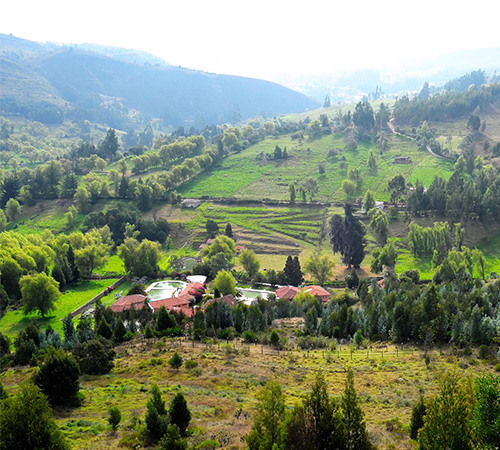History
Know our roots
The frist reference of the use of the water located on the area of Iza – Cuítiva dates from the 16th century when Fray Pedro Simón described the use of thermal water of the region of Muiscas indigenous, who were the people that inhabited the actual departments of Boyaca and Cundinamarca. Simón mentioned: “, here are many parts with hot water, still extremely hot and very healthy for bathing, as are those of Iza in the Sogamoso Valley, those of Chuachí, two miles from this city of Santafé, and others in the town of Nemocón, where it is an admirable thing that there are three fountains in triangle, little more than a stone’s throw from each other, the one hot and the other one salty, and the other sweetest, cold and thin, from which the people drink.”
In 1853 Don Manuel Ancizar geographer in charge of the Corographic Commission directed by Agustín Codazzi for Boyacá and Santander, in his work The Pilgrimage of Alpha mentioned the place: “Further south, in the place called Batán, there are three fountains of 40 to 43 degrees, simply ferruginous, which weavers of cloths and blankets take advantage of to crush them, soaking them with their feet. These fountains feel to come under ground by the skirt of a hill, whose circumstance suggested to the owner of the soil the idea of establishing a garden on those natural stoves, prospering there the oranges, the pineapples and other fruits of warm earth, surrounded by the vegetation and landscape of the upper Andean region, as the height of Batán is 2,594 meters above sea level. These phenomena are, in my opinion, linked to those of the Salitre and Paipa, because they depend, under certain topographic respect, on the western branch of the mountain range that dominates them and distributes them according to the sinuosities of their axis: an examination of the sites, done by an intelligent and experienced person in geology, would not lack interest, and perhaps useful for some branches of local industry…”
Almost a century and a half later to the description of Ancízar and by the recommendation of a colleague and eminent scientific friend, Doctor Luis Patiño Camargo, already retired from the National University of Colombia, the anesthesiologist Abel de Jesús Castro Castro ending the decade of the 70, accessed the text of Ancízar and fascinated by the history, looked for these springs only known by the locals of the population of Cuítiva, where emanated a large source of odorless hyperthermal water with a particular flavour, not studied to date in terms of its physico-chemical characteristics. Faced with this discovery and the offer of sale by an owner near the pit mentioned, Doctor Castro acquired the land and began to build a thermal water pool, found other underground wells on the site itself and subsequently acquired the site where the main spring sprouted, he designed and built an access road to the site, as well as a first house for recreational purposes, that promptly adapted on the advice of a friend to the field of hospitality, He later designed a natural Turkish bath that continues to function so far. The place kept the name of “Batán”, in honor of what was recorded in the text of Ancízar called first Hostería Balneario El Batán, name that over time was transformed to Hotel Termales el Batán, which is now projected into the future as a medical wellness centre in line with international standards and norms.









Lorem ipsum dolor sit amet, consectetur adipiscing elit, sed do eiusmod tempor incididunt ut labore et dolore magna aliqua. Ut enim ad minim veniam, quis nostrud exercitation ullamco laboris nisi ut aliquip ex ea commodo consequat.